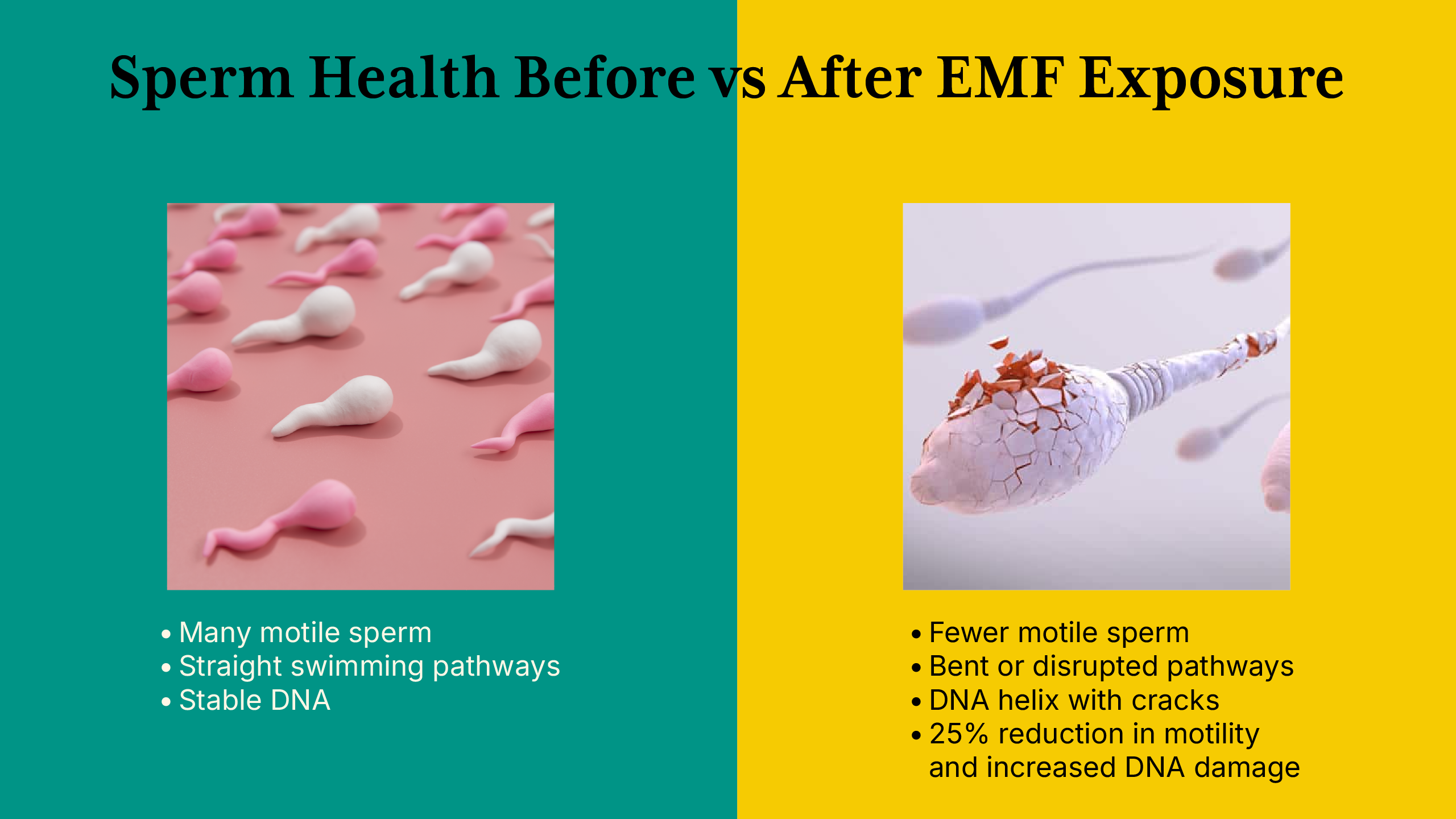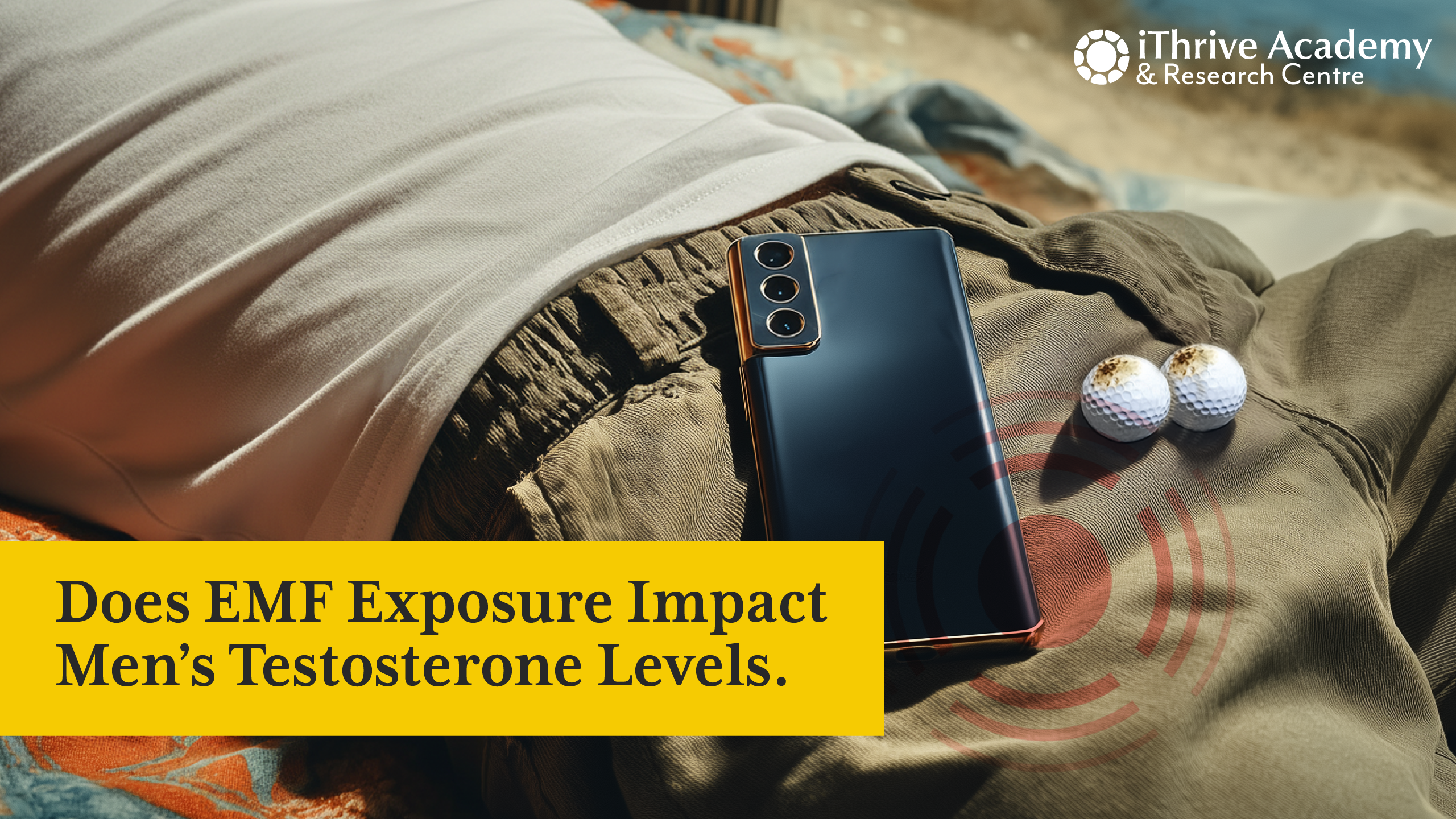Testosterone defines much more than masculinity. It shapes a man’s vitality, mood, metabolism, fertility, and overall resilience. Yet modern men are reporting low testosterone levels earlier than any previous generation. Fatigue, declining libido, difficulty building muscle, irritability, increased abdominal fat, and lowered fertility have become shockingly common experiences. While lifestyle, diet, stress, and environmental toxins are major contributors, a new question has entered the health conversation: Does EMF exposure impact testosterone?
Electromagnetic fields that are emitted by smartphones, WiFi routers, laptops, Bluetooth devices, smartwatches, and even home appliances are now a constant part of daily life. These EMF exposures were once rare; today they surround the body 24/7. And emerging research suggests that this invisible electrosmog may influence male hormones far more deeply than we once imagined.
At iThrive Academy, India’s first academy to teach Functional Nutrition, we examine health through the interconnectedness of biology, environment, and metabolism. The relationship between EMF exposure, testosterone levels, and men’s reproductive health is a powerful example of how modern lifestyle stressors affect the body on a cellular level. And understanding this connection is essential.
How EMF Exposure Interacts With Male Hormone Biology

The question “Does EMF affect testosterone?” is no longer hypothetical. Research over the past decade has shown that EMF radiation effects extend far beyond thermal heating, they alter the body’s biochemical pathways, increase oxidative stress, and also disrupt cellular communication, all of which are closely tied to hormone production.
Unlike ionizing radiation, EMFs do not directly break DNA strands. Instead, they function as biological stressors, triggering inflammation, weakening antioxidant defenses, and altering mitochondrial function. For men, this becomes especially relevant because the testes are highly sensitive organs, both electrically and metabolically.
When EMFs interfere with cellular electrical gradients and electron flow, the Leydig cells (the testosterone-producing cells in the testes) become vulnerable to oxidative damage. Over time, this oxidative stress can result in lowered testosterone synthesis, impaired spermatogenesis, and increased DNA fragmentation in sperm.
But the story doesn’t end there. EMF exposure affects hormone health indirectly as well by elevating cortisol, disturbing circadian rhythm, and impacting the body’s natural detoxification capacity. And in Functional Nutrition, we understand that anything that increases chronic inflammation will eventually influence reproductive health.
This parallels insights from our blog on broader environmental stressors,“Decoding the Boom: Why Functional Foods Are Gaining Popularity in India”, where we discuss how modern stresses, and not just diet, influence long-term health.
What Research Reveals About EMFs and Sperm Health

Some of the clearest evidence of EMF’s impact on men’s health comes from studies examining sperm quality. One of the most cited findings is from research where sperm samples were placed near a WiFi-connected laptop for just four hours. The results were striking: 25% of the sperm exposed to EMF became immobile, compared to 14% in the control sample. Additionally, 9% of the exposed sperm showed DNA damage, nearly double the rate seen in unexposed samples.1
Another study highlighted that young men using laptops close to their groin region had significantly poorer sperm counts.2 These findings align with broader global research showing reduced motility and increased oxidative stress in sperm exposed to mobile phone radiation.
These findings echo concerns raised in our dedicated piece, “EMF Exposed: The Shocking Truth About Daily Radiation.” That blog dives deep into how persistent EMF exposure disrupts bioelectric systems and cellular communication.
Why does this matter?
Because sperm quality is often the first indicator of deeper endocrine disruption. Even before testosterone levels drop, the reproductive system begins showing signs of oxidative overload, inflammation, and mitochondrial dysfunction - all commonly seen in men with high EMF exposure.
These results reinforce something Functional Nutrition has long emphasized: toxins don’t need to break DNA to create disease; they need only disrupt the cell’s internal environment. EMFs appear to do exactly that, especially when exposure occurs close to the reproductive organs.
How EMFs Influence Testosterone Levels and Endocrine Function
Multiple biological pathways link EMF exposure to low testosterone in men. One of the most important mechanisms is stress-induced hormonal disruption. When the body perceives EMF exposure as a stressor, cortisol levels rise. Chronic cortisol elevation is a well-known inhibitor of testosterone synthesis. It affects the brain’s signals to the testes, interferes with hormone-receptor binding, and slows down the enzyme pathways needed for testosterone production.
Additionally, EMFs can alter circadian rhythms by interfering with melatonin, a hormone essential for sleep quality and antioxidant protection. Poor sleep alone is associated with up to a 10 to 15% drop in testosterone within a week.
A lesser-known but crucial factor is how EMFs influence structured (EZ) water inside cells. Studies show that continuous exposure to non-native EMFs reduces cellular EZ water by 15 to 20%.3 This intracellular dehydration disrupts metabolism at a mitochondrial level and since testosterone synthesis is an energy-intensive process, compromised mitochondrial function directly affects hormone production.
Finally, EMFs promote inflammatory cytokine release, reducing antioxidant capacity and increasing free radicals. This creates a toxic internal environment where Leydig cells struggle to survive, let alone produce optimal hormone levels.
In Functional Nutrition terms, EMFs don’t simply “lower testosterone.” They shift the entire metabolic terrain of a man’s body toward stress, inflammation, and oxidative burden, all of which ultimately lead to hypogonadism and impaired fertility.
Modern Lifestyle, EMFs, and Hidden Hormone Stressors

Most men today are exposed to EMFs in ways previous generations never experienced. Smartphones remain in trouser pockets for hours. Laptops sit directly on laps. Smartwatches constantly transmit pulses into the wrist. Rooms are filled with WiFi routers, Bluetooth speakers, wireless earbuds, and IoT devices.
This creates a constant low-level electromagnetic load, a stress not strong enough to be felt, but powerful enough to change cellular behaviour over time.
Functional health practitioners studying iCFN learn how environmental toxins including EMF radiation often cluster with other stressors like poor sleep, high sugar intake, nutrient deficiencies, heavy metals, and chronic stress. Together, they overload mitochondria, weaken detoxification pathways, and create hormonal imbalances long before symptoms appear.
Low testosterone causes in men today cannot be explained by lifestyle alone. Environmental disruptors such as EMFs must be part of the conversation.
This systems-based perspective is very similar to what we discuss in our “5 Pillars of Gut-Brain Health” blog, where we explore how gut, inflammation, sleep, and environmental stressors (including EMFs) are deeply interconnected.
Reducing EMF Exposure: Practical, Science-Backed Strategies
While it is impossible to eliminate EMFs entirely, it is absolutely possible to reduce biological impact. Research-informed steps include:
- Keeping mobile phones away from the groin area, avoiding trouser pockets, and using speaker or wired options instead of keeping devices close to the body.
- Not using laptops directly on the lap; creating distance dramatically reduces exposure.
- Turning off WiFi at night and charging devices away from the bedroom to protect circadian rhythms and hormone regulation.
- Sleeping with phones on airplane mode to reduce nighttime radiation effects.
- Avoiding wearable tech while sleeping, as constant EMF pulses may deplete cellular EZ water and increase oxidative stress.
- Using Faraday cases or EMF-defender pouches to minimize direct exposure.
These shifts are not extreme, they are rather biological investments.
Why Functional Nutrition Education Matters in the EMF Conversation
Understanding EMF exposure symptoms, hormonal disruption, mitochondrial stress, and inflammation requires deep knowledge of how the human body interacts with energy and environment. At iThrive Academy, India’s first Functional Nutrition academy these concepts are taught within a scientific, evidence-driven framework.
Through the iThrive Certified Functional Nutrition (iCFN) program, practitioners learn to analyze biomarkers, identify environmental stressors, decode hormone patterns, and create personalized recovery strategies. Short courses such as Basics of Nutrition Science, and Nutrition for Heart Health deepen this understanding by connecting EMF exposure with cellular healing mechanisms.
This is the kind of education modern practitioners need because future healthcare is not just about food; it is about decoding how biology responds to the world around us.
To understand how root-cause testing supports this training, our blog “Why Every Functional Nutritionist Must Learn Advanced Testing for Better Client Outcomes” offers a deep dive into biomarker interpretation and protocol design.
Final Thoughts: Empower, Pioneer, Transform
EMF exposure is not a trend topic, it is a new biological reality. And evidence increasingly reveals that it plays a significant role in declining testosterone levels, poor sperm health, and metabolic imbalance in men. By understanding how EMFs influence stress, mitochondria, sleep, inflammation, and hormone production, we empower men to protect their reproductive health with clarity and intention.
At iThrive Academy, we continue to empower practitioners with deep, multidisciplinary knowledge, pioneer research-driven functional nutrition education, and transform how modern health challenges are understood and solved.
The invisible world of EMFs may be complex but with the right knowledge, men can reclaim vitality, balance, and hormonal strength.
Reference List
- https://www.academia.edu/23298137/Use_of_laptop_computers_connected_to_internet_through_Wi_Fi_decreases_human_sperm_motility_and_increases_sperm_DNA_fragmentation
- https://www.tandfonline.com/doi/full/10.1080/20905998.2024.2381957
- https://www.researchgate.net/publication/353961944_Impact_of_Wi-Fi_Energy_on_EZ_Water








.jpg)








